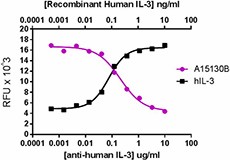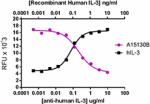- Clone
- A15130B (See other available formats)
- Regulatory Status
- RUO
- Other Names
- Interleukin-3, Burst promoting activity, Eosinophil colony stimulating factor (Eo-CSF), Hematopoietic cell growth factor (HCGF), Mast cell growth factor (MGF/MCGF), Multi-colony stimulating factor (multi-CSF), P cell stimulating activity (PCSA)
- Isotype
- Mouse IgG2b, κ

-

Recombinant human IL-3 induces the proliferation of TF-1 cells in a dose dependent manner (black squares). Ultra-LEAF™ purified anti-human IL-3 antibody (clone A15130B, purple circles) neutralizes the TF-1 cell proliferation induced by recombinant human IL-3 (1.0 ng/mL). The ND50 = 0.3 - 1.5 µg/mL.
| Cat # | Size | Price | Quantity Check Availability | ||
|---|---|---|---|---|---|
| 694303 | 100 µg | $270.00 | |||
| 694304 | 1 mg | $715.00 | |||
Select size of product is eligible for a 40% discount! Promotion valid until December 31, 2024. Exclusions apply. To view full promotion terms and conditions or to contact your local BioLegend representative to receive a quote, visit our webpage.
Interleukin-3 (IL-3) is a hemopoietic growth factor involved in the survival, proliferation, and differentiation of multipotent hemopoietic cells. IL-3 is the most potent growth factor for basophils, followed by granulocyte-macrophage colony-stimulating factor, and IL-5. These cytokines also act on mature basophils through specific receptors, thereby mediating adhesion, migration, and releasability. IL-3 is highly expressed by mast cells, and large and rapidly released amounts of autocrine IL-3 production are responsible for mast cell survival by IgE in the absence of antigen. IL-3 has also been implicated in the pathogenesis of several chronic inflammatory diseases, including: asthma, atherosclerosis, and neurodegenerative disorders, such as multiple sclerosis. IL-3 stimulates colony formation of megakaryocytes, neutrophils, and macrophages from bone marrow cultures. IL-3 plays a vital role in stimulating basophils and mast cell responses to parasite infections, and since basophils play an important role in Th2 immune responses, IL-3 is a critical regulator of allergic inflammation. IL-3 is expressed in the major embryonic vessels and regulates the survival and proliferation of hematopoietic stem cells in the early stages of embryonic development.
Product Details
- Verified Reactivity
- Human
- Antibody Type
- Monoclonal
- Host Species
- Mouse
- Immunogen
- Recombinant human IL-3
- Formulation
- 0.2 µm filtered in phosphate-buffered solution, pH 7.2, containing no preservative.
- Preparation
- The Ultra-LEAF™ (Low Endotoxin, Azide-Free) antibody was purified by affinity chromatography.
- Concentration
- The antibody is bottled at the concentration indicated on the vial, typically between 2 mg/mL and 3 mg/mL. Older lots may have also been bottled at 1 mg/mL. To obtain lot-specific concentration and expiration, please enter the lot number in our Certificate of Analysis online tool.
- Storage & Handling
- The antibody solution should be stored undiluted between 2°C and 8°C. This Ultra-LEAF™ solution contains no preservative; handle under aseptic conditions.
- Application
-
Neut - Quality tested
- Recommended Usage
-
Each lot of this antibody is quality control tested by neutralizing activity. The ND50 is 0.3 – 1.5 µg/mL. It is recommended that the reagent be titrated for optimal performance for each application.
- RRID
-
AB_2650727 (BioLegend Cat. No. 694303)
AB_2650727 (BioLegend Cat. No. 694304)
Antigen Details
- Structure
- Cytokine
- Distribution
-
Activated T cells, Th1, Th2, mast cells, eosinophils, keratinocytes, NK cells, and endothelial cells.
- Function
- IL-3 is a pleiotropic factor which promotes both self-renewal and differentiation of early multipotential progenitors and is involved in inducible hematopoiesis in response to infections.
- Interaction
- Erythroid cells, megakaryocytes, neutrophils, eosinophils, basophils, mast cells, monocytic lineages.
- Ligand/Receptor
- Heterodimer IL-3Rα (CD123) and a common β subunit (βc) that is shared with the IL-5R and GM-CSFR.
- Cell Type
- Endothelial cells, Eosinophils, Mast cells, NK cells, T cells, Th1, Th2
- Biology Area
- Cell Biology
- Molecular Family
- Cytokines/Chemokines
- Antigen References
-
1. Kitamura T, et al. 1989. J. Cell. Physiol. 140:323.
2. Kohno M, et al. 2005. Blood 105:2059.
3. Murphy JM, Young IG. 2006. Vitam. Horm. 74:1.
4. Kleemann R, et al. 2008. Cardiovasc. Res. 79:360.
5. Valent P, and Dahinden CA. 2010. Curr. Opin. Hematol. 17:60.
6. Mirza S, et al. 2010. J. Biol. Chem. 285:22370. - Gene ID
- 3562 View all products for this Gene ID
- UniProt
- View information about IL-3 on UniProt.org
Other Formats
View All IL-3 Reagents Request Custom Conjugation| Description | Clone | Applications |
|---|---|---|
| Ultra-LEAF™ Purified anti-human IL-3 | A15130B | Neut |
Compare Data Across All Formats
This data display is provided for general comparisons between formats.
Your actual data may vary due to variations in samples, target cells, instruments and their settings, staining conditions, and other factors.
If you need assistance with selecting the best format contact our expert technical support team.
-
Ultra-LEAF™ Purified anti-human IL-3

Recombinant human IL-3 induces the proliferation of TF-1 cel...
